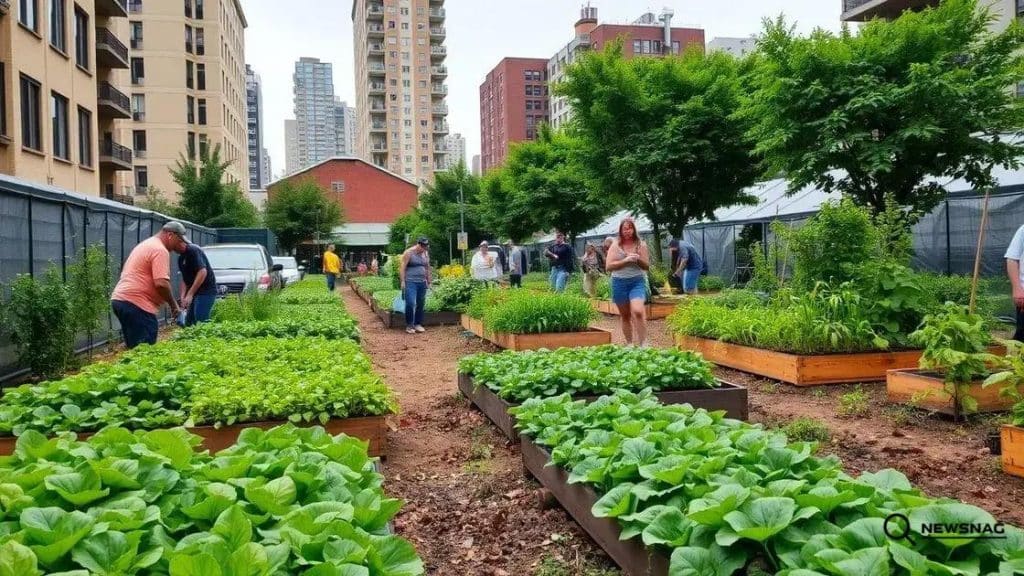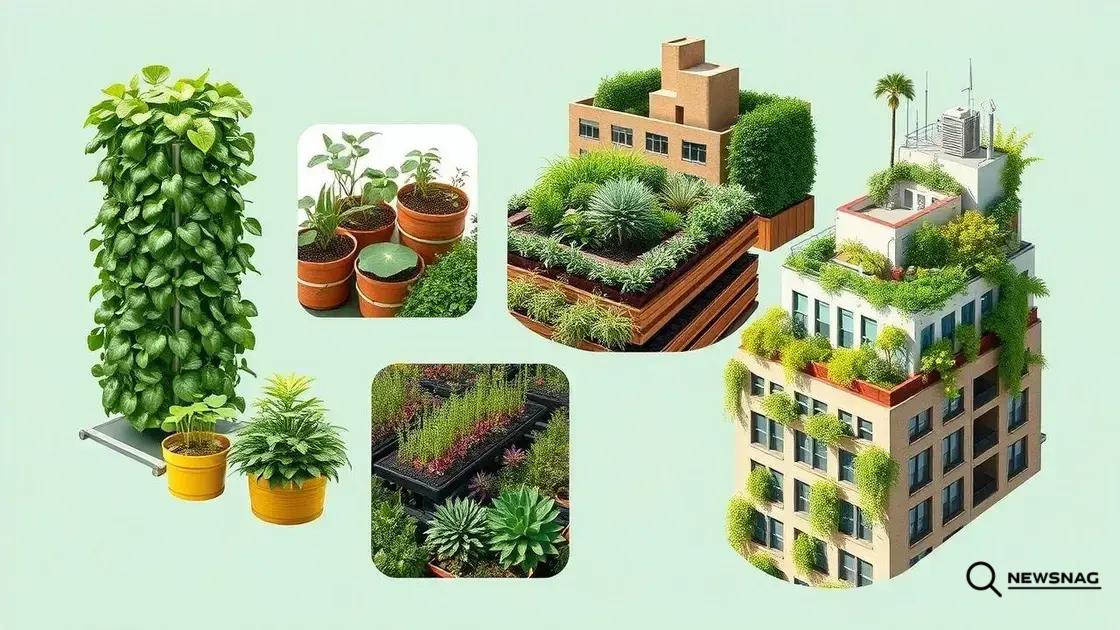Urban farming initiatives: cultivating green spaces

Anúncios
Urban farming initiatives are transforming city landscapes by improving food security, fostering community engagement, and promoting sustainable practices through innovative technologies and community involvement.
Urban farming initiatives are becoming a vibrant solution for city dwellers looking to connect with nature and grow their own food. Have you ever wondered how these projects can reshape urban environments and foster community ties?
Anúncios
Understanding urban farming initiatives
Understanding urban farming initiatives is essential for grasping how cities adapt to modern challenges. These projects not only beautify urban areas but also address food security, community engagement, and sustainability.
What is Urban Farming?
Urban farming refers to the practice of cultivating, processing, and distributing food within city environments. By using small areas, like rooftops or vacant lots, residents can produce fresh food close to home.
Benefits of Urban Farming
These initiatives offer numerous advantages:
Anúncios
- Improved food access: Urban farms provide fresh produce in neighborhoods lacking grocery stores.
- Environmental sustainability: Green spaces help improve air quality and support biodiversity.
- Community bonding: They encourage residents to come together, fostering social ties.
Moreover, urban farming practices promote sustainability by reducing the carbon footprint associated with transporting food. They often incorporate techniques like composting, rainwater harvesting, and vertical gardening, making them environmentally friendly choices.
Participation in these projects can also boost local economies, creating jobs and encouraging entrepreneurship. Many urban farms sell their products at local markets or through community-supported agriculture (CSA) programs, keeping money within the community.
These initiatives are supported by various organizations and local governments aiming to promote urban agriculture. They provide resources, training, and sometimes funding to empower residents.
Benefits of green spaces in cities
The benefits of green spaces in cities extend far beyond simple aesthetics. Green areas provide essential ecological services, enhance community well-being, and improve urban living conditions, which is vital in today’s crowded cities.
Health Benefits
Access to green spaces significantly improves public health. Studies show that spending time in nature can reduce stress and boost mental health.
- Physical activity: Parks encourage exercise, promoting healthier lifestyles.
- Social interaction: Green spaces foster community connections, reducing feelings of isolation.
- Improved air quality: Plants filter pollutants, contributing to cleaner air.
Additionally, they can serve as natural cooling areas, helping to regulate temperatures in urban settings. This is especially important during heatwaves, as heat islands become more prevalent.
Environmental Impact
Green spaces contribute significantly to biodiversity in urban areas. They provide habitats for various species, which is crucial for maintaining ecological balance.
Moreover, these areas play a vital role in stormwater management. They absorb rainwater, reducing runoff and the risk of flooding. By enhancing the urban ecosystem, they also help mitigate climate change effects.
Investing in green spaces can lead to increased property values, attracting businesses and residents alike. They make cities more attractive, promoting tourism and boosting local economies.
Innovative projects around the world

Innovative projects around the world showcase how urban farming can transform cities into greener, more sustainable spaces. These initiatives demonstrate creativity in utilizing small urban areas to grow food and foster community connections.
Vertical Farming
One of the most exciting advancements is vertical farming. This method involves growing crops in stacked layers, often using hydroponics or aeroponics. It allows farming in urban settings where space is limited. Many cities have embraced vertical farms, using building rooftops for food production.
- Efficient use of space: Vertical farms maximize yield in a small footprint.
- Reduced transport costs: Local production cuts down on delivery times.
- Year-round growing: Controlled environments allow for constant crop cycles.
Examples include the farm at Brooklyn Grange in New York and Sky Greens in Singapore, both of which highlight a modern approach to sustainability.
Community Gardens
Another innovative project type is community gardens. These spaces allow residents to cultivate their own crops and participate in gardening activities. They serve not just as food sources but also as community hubs.
Various cities encourage the establishment of these gardens, which often include:
- Educational programs: Teaching gardening skills and sustainability practices.
- Food sharing: Providing fresh produce within the community.
- Social engagement: Encouraging collaboration among neighbors.
In cities like Detroit and Los Angeles, community garden initiatives have revitalized neighborhoods, bringing fresh food and fostering social ties.
Moreover, initiatives like rooftop gardens on urban buildings contribute to biodiversity while providing accessible green spaces. They also help with energy efficiency in buildings by insulating rooftops.
Community engagement in urban gardens
Community engagement in urban gardens is crucial for their success and sustainability. These gardens not only provide fresh produce but also help strengthen community ties and promote social well-being.
Building Relationships
Urban gardens serve as spaces where neighbors can connect. People of all ages come together to learn gardening skills and share knowledge. This interaction fosters friendships and community pride.
- Skill-sharing: Experienced gardeners can teach newcomers, building a sense of collaboration.
- Events and workshops: Organizing community events enhances participation and engagement.
- Collective decision-making: Involves community members in decisions about garden management.
Through these interactions, urban gardens become social hubs where various cultures and backgrounds blend, enriching the community experience.
Promoting Volunteerism
Volunteering is a key aspect of urban gardens. Residents contribute time and effort to maintain the garden. This involvement not only yields fresh produce but also creates a sense of ownership.
Volunteers can:
- Help with planting: Take part in seasonal planting activities.
- Maintain the garden: Participate in regular upkeep tasks.
- Organize community meals: Host events featuring produce from the garden.
These activities foster a spirit of cooperation, promoting a healthier environment and lifestyle. It’s a collective effort that makes a difference.
Additionally, urban gardens often collaborate with local schools and organizations, creating educational opportunities for young people. They learn about nutrition, sustainability, and the importance of community involvement.
The future of urban agriculture
The future of urban agriculture looks bright as cities continue to innovate and adapt to modern challenges. With a growing population and changing climate, urban farming initiatives are becoming essential for sustainable living.
Technological Advancements
Technology plays a crucial role in shaping the future of urban agriculture. Innovations such as smart farming techniques help optimize resources and increase yields.
- Vertical farming: By using vertical space, urban farms can grow more food with less land.
- Hydroponics and aquaponics: These methods allow farming without soil, using water-efficient systems to cultivate plants.
- Automated systems: Robots and drones can monitor crops and assist in planting and harvesting.
These technologies make urban farming more efficient and accessible for city residents.
Sustainability and Climate Resilience
The focus on sustainability is another driving force for the future. Urban farms contribute to climate resilience by reducing the urban heat island effect and improving air quality. Integrating nature into city designs can help combat climate change.
Many cities are now adopting policies that promote green spaces and urban agriculture. These include:
- Incentives for green roofs: Encouraging builders to create gardens on rooftops.
- Support for local farmers: Providing funding for community agriculture projects.
- Education programs: Teaching residents about sustainable practices and gardening.
These initiatives not only benefit the environment but also enhance community health and well-being.
As awareness of food deserts grows, urban agriculture is also becoming a critical solution for improving food access. Cities will increasingly invest in local food systems to ensure residents have access to fresh, healthy produce.
The future of urban agriculture is promising and full of potential. With innovative technologies and sustainable practices, cities can better address food security and foster community well-being. As urban residents engage in farming, they not only connect with their food sources but also contribute to a healthier environment. By embracing these changes, cities can become greener places that encourage collaboration and resilience, ensuring a brighter future for all.
FAQ – Frequently Asked Questions about Urban Agriculture
What are the benefits of urban agriculture?
Urban agriculture improves food security, enhances community ties, and promotes sustainability in cities.
How does technology impact urban farming?
Technology like vertical farming and hydroponics increases efficiency, allows for year-round production, and minimizes resource usage.
Can urban agriculture address food deserts?
Yes, urban agriculture initiatives can directly provide fresh produce in areas lacking access to grocery stores.
How do community gardens promote engagement?
Community gardens bring neighbors together, allowing them to work collaboratively, share knowledge, and strengthen social bonds.





